Somewhere in Indiana…
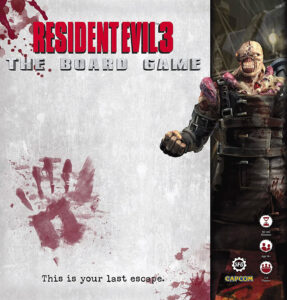 I doze off while fellow reviewer Andrew recalculates the impact of his brilliant cube pushing maneuver for the fourth time. He is really invested in winning “Cubes and Spreadsheets: Who Needs Excel?: The Board Game.” I… am not.
I doze off while fellow reviewer Andrew recalculates the impact of his brilliant cube pushing maneuver for the fourth time. He is really invested in winning “Cubes and Spreadsheets: Who Needs Excel?: The Board Game.” I… am not.
Suddenly, there is a bright light followed by a loud crash. The skies open up and, almost simultaneously, the power goes out. With cat-like reflexes that defy Andrew’s appearance, he leaps under the table and reappears with a Desert Eagle in his hand.
“I have been preparing for this for YEARS!” he cackles triumphantly. For the next fifteen seconds, Andrew scans the room for… what, I have no idea. All that can be heard is the rain crashing on the roof.
I decide to address Andrew Wick. “You prepared for a power outage… by having a gun?”
“No!” Andrew bellows. “This is one of two things. Either the zombie apocalypse is upon us… or I have been cursed by Steam Forged Games accidentally sending THIS monstrosity to my house.” He trails off as he ninja-rolls out of the room and, just as quickly, ninja-rolls back in with a box in his hand.
“HOW DARE THEY SEND THIS TO MY HOME!” he exclaims, holding up Resident Evil 3 The Board Game.
“Nice!” I squeal, taking it out of his hands. “I’ll break the curse of your home and you can take care of the zombies.” With that, I jump in my Civic, run over three approaching zombies, and drive home.
That is the true story of how I received my copy of Resident Evil 3 The Board Game.
Gameplay Overview:
Resident Evil 3, published by Steamforged Games, is a campaign based, cooperative survival horror board game for one to four players. You could play the missions as one offs, but why would you? I digress. Individual missions can take between 45 and 120 minutes, with the entire campaign lasting about 20 hours.

A mission lasts an undetermined number of player turns, with a player turn consisting of the following three phases:
Action Phase: Players perform up to four actions of the following actions (actions can be repeated): Move one space, Open/Close a door, Search when a player is on an item token, Trade with an adjacent player, Use an item, Attack
Reaction Phase: All enemies that can attack will attack a player that is in range (it does NOT have to be the active player). Any enemies that do not attack and are on a linked tile (tiles where a path from the enemy to any player does not pass through a closed door) move toward that player
Tension Phase: A tension card is drawn and resolved (additional effects may trigger, depending on the City Danger Level)
The next player in clockwise order then performs their turn, and this will repeat until the mission is completed successfully or fails. When playing a campaign, there is an additional end phase for campaign cleanup and preparation for the next mission.
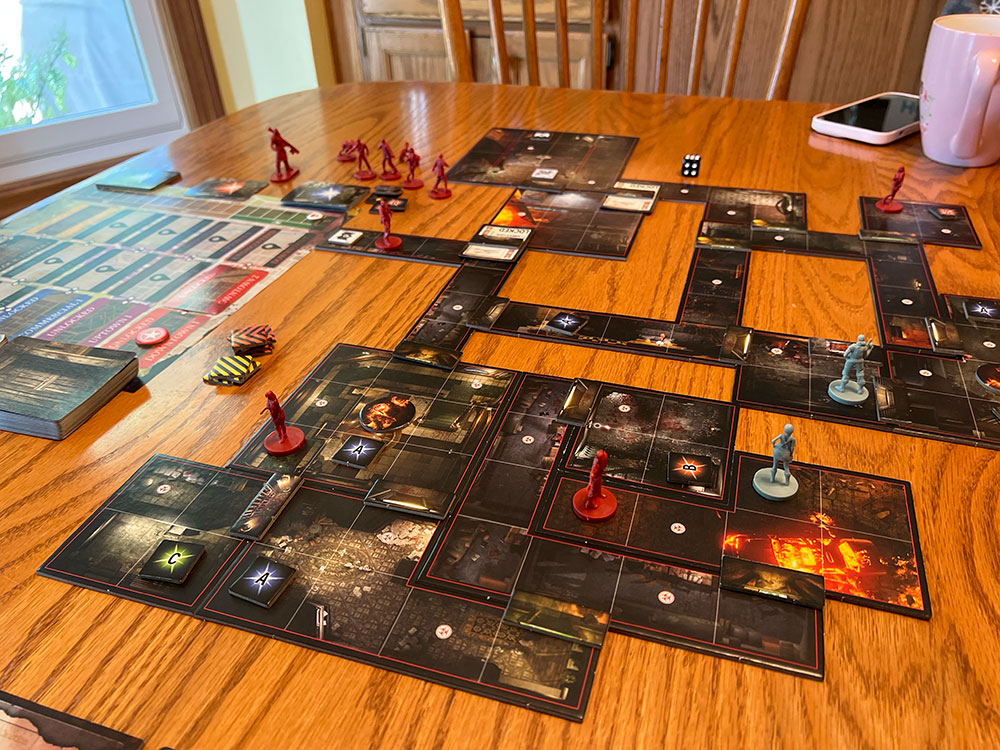
Game Experience:
Resident Evil 2 (the first Resident Evil title released by Steamforged Games) received a lukewarm response. That, combined with Resident Evil 3 being my least favorite of the original three Resident Evil video games, lowered my expectations for this game. After playing this game many times, I can safely say it is one of my favorite cooperative games that I own. So, what makes this game so good?
My favorite aspect of the game is the tension that it creates. The tension comes from two different gameplay mechanisms.
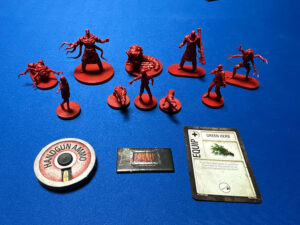
First, there is the tension deck. A tension card is revealed at the end of each player’s turn. The deck starts out harmless enough, with most of the cards being “All Clear.” Nothing happens. But at the start of each new mission, you will add yellow and red tension cards to the deck, which remain in the deck for all future missions and… well, let’s just say they are not “All Clear.” Some will force you to stay in your room or leave the room you are in on your next turn or there is a penalty. Some move the nearest enemy to your space in an ambush. Naturally, if you draw a streak of “All Clear” cards, tension increases as you KNOW a bad card, or cards, will be coming soon. What happens if the Tension Deck runs out of cards? Unless you are in one of the beginner missions, you fail the mission. So, yeah, it is a timer as well.
In addition, there is the City Danger Level (CDL). As events happen and you progress further into the campaign, the CDL will increase. Many of the yellow and red tension cards have symbols on them that match symbols on the CDL track. If the danger level meets or exceeds the symbol on the revealed tension card, additional bad things happen. Great. Watching the deck get smaller and smaller, seeing the objectives you have yet to complete, and knowing your time is dwindling made me love/hate the Tension Deck. It is such a well-designed mechanism, but I despise it.
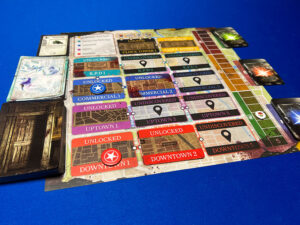
Finally, how monsters are controlled adds to the tension of Resident Evil 3. They do not have their own turns. I already mentioned they move after a player uses their four actions. But they also move if you attack and fail to hit your target. ALL ENEMIES on linked tiles move. Also, they move towards the nearest character, not just towards the character who Stormtroopered their shot. This can really mess up your teammate’s plans! Basically, every attack you make COULD trigger a massive zombie migration. You also automatically get hit by an enemy if they are in your space when you attack and miss. Last, if you attempt ANY action with an enemy in your space, if you fail the evade roll your action is interrupted and you are hit. This is not Zombicide. You can’t (and won’t) just shoot everything in sight because failed attacks have consequences. And I love it!
I also love the campaign. Like the video game, you will need to discover key (pun not intended, even though they are often keys) items to open and access other missions. You can choose from three areas at the start of the game, which branch into other areas after they are successfully completed. Players are attempting to gather four items to access the Clocktower and the final two missions. To accomplish this, the other 12 missions must be completed, but the order can vary every time you play. Each mission adds different cards to the tension deck as well as has different impacts on the CDL. Every mission starts with unexplored areas marked on the map and when these areas are explored, a D6 is rolled to determine what is behind the door. Different narrative events can impact your campaign. All of this created a campaign that I enjoyed and added decent replay value when compared to linear campaigns I have played in the past.
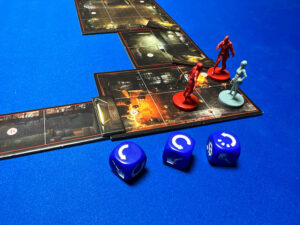
Fourth, I love that it is true to its survival horror roots. You cannot fight everything. The fun of opening closing doors to manipulate your enemies, especially the zombies, is very enjoyable. You will want to balance taking longer to shut doors and breaking linked tiles to minimize enemy activity with making sure you do not run out of time. I have never felt tension like this in a board game before. The combination of the tension decks, monster reactions and a time crunch in a campaign setting is so fun.
Quick hits before I get to my complaints:
• Minis, while small, are good
• Combat and deciding when to fight vs. run is fun
• EXCELLENT solo game
While I truly enjoy this game, I do have a couple of (minor) complaints.
First, I wish there was more character and enemy variety. There are only four characters to play as in the retail version. Because each character is different, and has different abilities and item capacities, having more characters would have increased replay value.
The same could be said for the enemies. This is not deal breaker (the zombies have three different sculpts and two different cards, effectively adding another monster type to the game) because there was not a significant variety of enemies in the video game. That being said, more enemy types would have been nice.
The other complaint is that the double-sided tiles are not labeled. The instructions say you can use any tile that fits the shape in the map, but this leads to weird tile layouts, like half of a burning car adjacent to a clean library in a house, which can take away from the theme of the map. I wish SFG had taken the time to label the tiles so players could more easily build a thematic map.
Final Thoughts:
If you like survival horror or Resident Evil, in particular, do yourself a favor and buy this game. No, it is not perfect (no game is). But I was blown away by the tension that this game created, from the aptly named tension deck, the monster reactions, and the ever-present City Danger Level. I love how true the game is to both survival horror and its IP. I would also recommend this at all player counts and for those that are looking for a solo survival horror game, this fits the bill perfectly.
I bought the Last Escape Expansion from the SFG website (review to be posted in the next couple of months) after completing the campaign so I could add more characters, enemies, and game types to Resident Evil 3. These are in no way needed to enjoy the retail version but shows how much I really enjoy the game!
Final Scores: 4.5 Stars – An excellent survival horror game that will not be leaving my collection anytime soon. Highly recommended!
 Hits:
Hits:
• The Tension deck is a great mechanism, serving the dual purpose of tension generator and game timer
• No monster turns, instead relying on monsters to react during each player’s turn, is brilliant
• Survival horror on your tabletop – you cannot fight every enemy, ammo is low and time is running out!
• Very thematic and true to the IP
• Fun at all player counts, especially Solo
Misses:
• Only four characters and three enemy types included in the retail version
• Tiles not labeled so the map can have tiles that, due to the art, look weird adjacent to each other
Source: Board Game Quest





